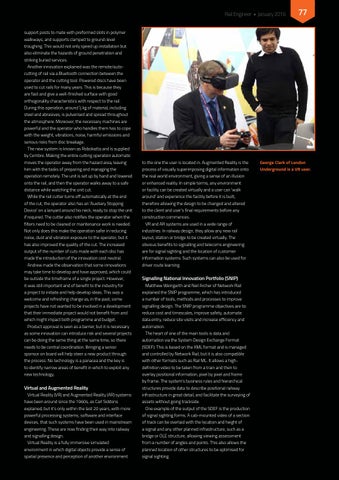Rail Engineer • January 2016 support posts to mate with preformed slots in polymer walkways, and supports clamped to ground-level troughing. This would not only speed up installation but also eliminate the hazards of ground penetration and striking buried services. Another innovation explained was the remote/autocutting of rail via a Bluetooth connection between the operator and the cutting tool. Powered discs have been used to cut rails for many years. This is because they are fast and give a well-finished surface with good orthogonality characteristics with respect to the rail. During this operation, around ½ kg of material, including steel and abrasives, is pulverised and spread throughout the atmosphere. Moreover, the necessary machines are powerful and the operator who handles them has to cope with the weight, vibrations, noise, harmful emissions and serious risks from disc breakage. The new system is known as Robokatta and is supplied by Cembre. Making the entire cutting operation automatic moves the operator away from the hazard area, leaving him with the tasks of preparing and managing the operation remotely. The unit is set up by hand and lowered onto the rail, and then the operator walks away to a safe distance while watching the unit cut. While the rail cutter turns off automatically at the end of the cut, the operator also has an ‘Auxiliary Stopping Device’ on a lanyard around his neck, ready to stop the unit if required. The cutter also notifies the operator when the filters need to be cleaned or maintenance work is needed. Not only does this make the operation safer in reducing noise, dust and vibration exposure to the operator, but it has also improved the quality of the cut. The increased output of the number of cuts made with each disc has made the introduction of the innovation cost neutral. Andrew made the observation that some innovations may take time to develop and have approved, which could be outside the timeframe of a single project. However, it was still important and of benefit to the industry for a project to initiate and help develop ideas. This was a welcome and refreshing change as, in the past, some projects have not wanted to be involved in a development that their immediate project would not benefit from and which might impact both programme and budget. Product approval is seen as a barrier, but it is necessary as some innovation can introduce risk and several projects can be doing the same thing at the same time, so there needs to be central coordination. Bringing a senior sponsor on board will help steer a new product through the process. No technology is a panacea and the key is to identify narrow areas of benefit in which to exploit any new technology.
Virtual and Augmented Reality Virtual Reality (VR) and Augmented Reality (AR) systems have been around since the 1960s, as Carl Siddons explained, but it’s only within the last 20 years, with more powerful processing systems, software and interface devices, that such systems have been used in mainstream engineering. These are now finding their way into railway and signalling design. Virtual Reality is a fully immersive simulated environment in which digital objects provide a sense of spatial presence and perception of another environment
to the one the user is located in. Augmented Reality is the process of visually superimposing digital information onto the real world environment, giving a sense of an illusion or enhanced reality. In simple terms, any environment or facility can be created virtually and a user can ‘walk around’ and experience the facility before it is built, therefore allowing the design to be changed and altered to the client and user’s final requirements before any construction commences. VR and AR systems are used in a wide range of industries. In railway design, they allow any new rail layout, station or bridge to be created virtually. The obvious benefits to signalling and telecoms engineering are for signal sighting and the location of customer information systems. Such systems can also be used for driver route learning.
Signalling National Innovation Portfolio (SNIP) Matthew Weingarth and Neil Archer of Network Rail explained the SNIP programme, which has introduced a number of tools, methods and processes to improve signalling design. The SNIP programme objectives are to: reduce cost and timescales, improve safety, automate data entry, reduce site visits and increase efficiency and automation. The heart of one of the main tools is data and automation via the System Design Exchange Format (SDEF). This is based on the XML format and is managed and controlled by Network Rail, but it is also compatible with other formats such as Rail ML. It allows a highdefinition video to be taken from a train and then to overlay positional information, pixel by pixel and frame by frame. The system’s business rules and hierarchical structures provide data to describe positional railway infrastructure in great detail, and facilitate the surveying of assets without going trackside. One example of the output of the SDEF is the production of signal sighting forms. A cab-mounted video of a section of track can be overlaid with the location and height of a signal and any other planned infrastructure, such as a bridge or OLE structure, allowing viewing assessment from a number of angles and points. This also allows the planned location of other structures to be optimised for signal sighting.
77
George Clark of London Underground is a VR user.
